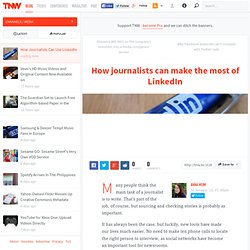

How to: use social media in newsgathering. Credit: Image by Pedro Lozano on Flickr.

Creative commons licence. Some rights reserved. Finding sources, nurturing contacts and checking facts by phone have long been key to successful journalism. This guide on using social media to research stories outlines the many ways reporters can put those traditional journalism skills into practice on social media platforms. The first problem in searching is one of noise. This guide gathers tips from Malachy Browne, news editor of social news gathering agency Storyful; David Wyllie, an editor at Breaking News, a social media breaking news service owned by NBC News; and investigative journalist and trainer in advanced online research skills Colin Meek. 1.
"The most important thing to do is to build systems of information and sources around your areas of interest," Browne said. There are a two main ways to organise information into columns on TweetDeck: Twitter lists and search terms. Lists 2. "I like to have a little bit of chaos," Wyllie explained. De digitale detective: spoorzoeken met social media - Herwin Thole. “After you, my distinguished British guest”, zegt Van Ess tegen Myers, terwijl hij de deur voor hem openhoudt. De twee heren hebben schik op deze halfzonnige ochtend en zetten de toon voor de rest van de dag. Op het programma staat een workshop over het expertisegebied van Van Ess en Myers: onderzoeksjournalistiek met behulp van digitale middelen. Locatie is het kantoor van IDFA. In een kleine bioscoopzaal aan het Frederiksplein in Amsterdam verzamelen zich een vijftiental regisseurs, ontwerpers, animators, programmeurs en journalisten.
9 Facebook accounts every college journalist should subscribe to. By Patrick Foster It’s been a little less than a year since Facebook launched the Subscribe feature, allowing us to see the public updates of users we are not friends with.

In that time, many journalists, as well as social and digital media experts, have begun using the feature to enhance their work, converse with their followers and share what they are passionate about. Below are nine accounts that any college journalist can (and should) subscribe to. They offer an array of viewpoints and great content, but more importantly, are superb models for using Facebook to expand your relationship with those who read your work. Additionally, Facebook offers this Subscribe for Journalists guide, if you’d like get started using the feature.
Images are from Facebook profiles. De digitale detective: spoorzoeken met social media. Wist je dat je sommige tweets van een afgeschermde twitteraccount toch kunt lezen?

Deze en andere trucs lieten onderzoeksjournalisten Henk van Ess en Paul Myers zien tijdens een masterclass digitaal spoorzoeken. “Je dacht dat je hier kwam voor een cursus zoeken, maar het is eigenlijk een taalcursus.” “After you, my distinguished British guest”, zegt Van Ess tegen Myers, terwijl hij de deur voor hem openhoudt. Timeline. Data visualisation DIY: our top tools. The Wikileaks war logs: every death recorded.

Get Bigger version What data visualisation tools are out there on the web that are easy to use - and free? Here on the Datablog and Datastore we try to do as much as possible using the internet's powerful free options. That may sound a little disingenuous, in that we obviously have access to the Guardian's amazing Graphics and interactive teams for those pieces where we have a little more time - such as this map of public spending (created using Adobe Illustrator) or this Twitter riots interactive.
But for our day-to-day work, we often use tools that anyone can - and create graphics that anyone else can too. So, what do we use? Google fusion tables This online database and mapping tool has become our default for producing quick and detailed maps, especially those where you need to zoom in. Geofeedia helps journalists locate real-time photos, tweets where news breaks. There are three challenges in using social media content for reporting, as Storyful’s Mark Little has written: finding it, verifying it, and figuring out the best way to publish it.

In breaking news situations, reporters often rely on text searches — names of places, keywords like “crash” or “fire,” and hashtags. They look for users whose bios mention a particular location. But it’s hit-or-miss. Even when they use the right terms, they have to wade through all the conversation from people who aren’t at the scene. Geofeedia, a service that comes out of private beta today, aims to solve this problem by enabling location-based searches for social media content. “Most news happens at a location,” said Phil Harris, CEO of Geofeedia. Hear about a shooting at a high school in near Cleveland? How Journalists Can Use LinkedIn. Many people think the main task of a journalist is to write.

That’s part of the job, of course, but sourcing and checking stories is probably as important. It has always been the case, but luckily, new tools have made our lives much easier. No need to make ten phone calls to locate the right person to interview, as social networks have become an important tool for newsrooms. This isn’t only about Facebook and Twitter; a professional network like LinkedIn can also prove very useful for reporters who know how to make the most of its advanced features.
Here are a few tips you may want to try out: 1. Looking someone up on LinkedIn is quite easy of you know their name. Besides basic options such as looking for someone who occupies a specific position at a certain company, you can add interesting filters to make sure you’ll find exactly what you are looking for. The drop-down menu below the Company search field is one of these small settings that can make a big difference. 2.
Les 9 week 5. Les 8 week 4. Les 7 week 4. Les 6 week 3. Les 5 week 3. Les 4 week 2. Les 3 week 2. Les 2 week 1. Les 1 week 1.